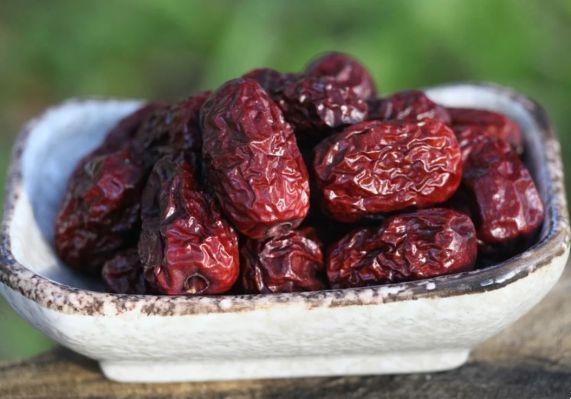
- Jujube: what it is and how it is consumed
- Properties and benefits of jujubes
- Nutritional values of jujubes
- Characteristics of the jujube tree
Jujube: what it is and how it is consumed
La jujube it is the fruit of the jujube, a small tree native to the Asian regions and today also widespread in the southern areas of Europe and the United States.
Jujube is one edible drupe slightly smaller than an apricot, slightly oval and with a thin and smooth brown-brown skin, which tends to red when ripe
La jujube pulp instead it is whitish and has a compact, sometimes floury consistency. The flavor of jujube is sweet and slightly acidic, similar to that of green or unripe apples.
Jujube fruits are eaten fresh immediately after harvesting or candied or dried. Jujubes are also used to prepare syrups, jams, candies and infusions or to fill sweets such as cakes and biscuits.
Furthermore jujubes can be preserved in spirit or used to prepare the jujube broth, a well-known liqueur obtained by macerating jujube fruits in alcohol.
Properties and benefits of jujubes
Jujube has been cultivated for over 4000 years for the commercialization of jujubes, which are used in the food sector and as a natural remedy in traditional medicines.
Fresh jujubes have a nutritional profile similar to that of figs and dates: in addition to being rich in sugars, they are a source of vitamin C, pro vitamin A and B vitamins.
Jujubes also provide our body with precious minerals, including iron, calcium, phosphorus and manganese. Jujube pulp also contains triterpene acids and saponosides and traditionally numerous properties have been attributed to this fruit.
Jujubes are in fact used as emollient remedy, antiseptic, anti-inflammatory e antispasmodic and are used to ensure the proper functioning of the liver and the gastrointestinal system, as well as the urinary, respiratory and cardiovascular systems.
Traditionally the dried jujubes are used to prepare mouthwashes and analgesic, antiseptic and expectorant lozenges used in the treatment of affections of the mouth, pharyngitis, bronchitis, cough and sore throat.
I dried jujube fruits they are also consumed to treat fatigue and stress, loss of appetite and diarrhea.
In China the infusions prepared with jujubes are administered as remedy in case of anxiety and insomnia, for the sedative and calming action, which promotes relaxation and good rest.
La pulp of the jujube is finally used to prepare a healing and soothing paste to be applied on wounds to speed up healing.
Nutritional values of jujubes
Fresh jujubes provide 79 calories and they contain about 20 g of carbohydrates and 1 g of protein per 100 g.
Dried jujubes, on the other hand, provide 287 calories and contain 74 g of carbohydrates and 4 g of proteins, again referring to 100 g of product.
Characteristics of the jujube tree
Jujubes are the fruits of the Zizyphus jujuba, a small tree belonging to the Rhamnaceae family, the same as the buckthorn and cascara.
The jujube is native to the Asian regions and it grows easily in areas with hot and dry climates. It is not uncommon to find jujube trees here too, as this species is now widely cultivated and also used for ornamental purposes.
The jujube shrub, which can reach 6-8 meters in height, has thorny branches, lanceolate and deciduous leaves and yellow flowers that open in spring. After flowering, the fruit, the jujube, develops from the flower of the jujube.


























